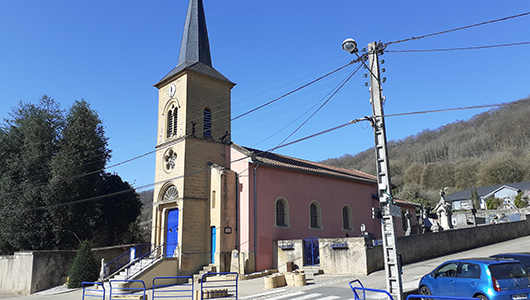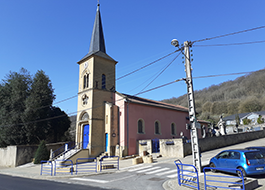Bronvaux
Durée visite : 10 min
Moyen : pédestre
Au débouché de la vallée du Billeron, le site de Bronvaux a été occupé de manière intermittente dès le néolithique, mais ce n’est qu’en 1137 que son existence est renseignée. Le village est alors désigné sous la forme latinisée de Vallis beveronis, ce qui signifierait « La vallée des castors » Il appartient aux moines de l’abbaye St-Martin de Metz, qui y développent la culture de la vigne. En 1186, il est intégré au comté de Bar. Dangereusement situé à la limite des zones d’influence et d’expansion des puissances de l’époque (comtes de Bar et de Luxembourg, évêque et cité de Metz), il est ravagé à plusieurs reprises durant le Moyen Âge. Une rue de la Sorcière rappelle l’emprisonnement d’une chevaucheuse de balai en 1583. Son développement au 19e est lié à la mine de fer de Ternel. Une main d’œuvre étrangère, notamment italienne, se fixe à Bronvaux :40 habitants sur 250 en 1898.
At the outlet of the Billeron valley, the site of Bronvaux has been occupied intermittently since the Neolithic, but it is only in 1137 that its existence is informed. The village is then designated in the Latinized form of Vallis beveronis, which would mean « The valley of the beavers » It belongs to the monks of the Abbey of St-Martin in Metz, who develop the culture of the vine there. In 1186, it was incorporated into the county of Bar. Dangerously located at the limit of the zones of influence and expansion of the powers of the time (counts of Bar and Luxembourg, bishop and city of Metz), it was ravaged several times during the Middle Ages. A rue de la Sorcière recalls the imprisonment of a broom rider in 1583. Its development in the 19th century is linked to the Ternel iron mine. A foreign workforce, especially Italian, settled in Bronvaux: 40 inhabitants out of 250 in 1898.
Am Auslass des Billeron-Tals ist der Standort Bronvaux seit dem Neolithikum zeitweise besetzt, aber erst 1137 wird seine Existenz bekannt gegeben. Das Dorf wird dann in der lateinisierten Form von Vallis beveronis bezeichnet, was « Das Tal der Biber » bedeuten würde. Es gehört den Mönchen der Abtei St. Martin in Metz, die dort die Kultur der Rebe entwickeln. Im Jahr 1186 wurde es in die Grafschaft Bar eingegliedert. Gefährlich an der Grenze der Einflusszonen und der Ausweitung der damaligen Mächte gelegen (Graf von Bar und Luxemburg, Bischof und Stadt Metz), wurde es im Mittelalter mehrmals verwüstet. Eine Rue de la Sorcière erinnert an die Inhaftierung eines Besenreiters im Jahr 1583. Seine Entwicklung im 19. Jahrhundert ist mit der Eisenmine Ternel verbunden. Eine ausländische Belegschaft, insbesondere Italiener, ließ sich in Bronvaux nieder: 1898 40 von 250 Einwohnern.

D’argent au gril d’azur, chapé d’azur à deux bars adossés d’or.
Les deux bras d’or sur fond d’azur sont les armes du duché de Bar, dont relevait Bronvaux, le chapé d’azur (chape de Saint Martin) évoque l’abbaye de Saint-Martin-lès-Metz (Ban-Saint-Martin) qui possédait la seigneurie, enfin le gril rappelle Saint Laurent, patron de !a paroisse.
Argent a grill Azure, capped Azure with two backing bars of gold.
The two golden arms on a background of azure are the arms of the Duchy of Bar, to which Bronvaux fell, the chapé azure (chape de Saint Martin) evokes the abbey of Saint-Martin-lès-Metz (Ban-Saint -Martin) who owned the seigneury, finally the grill recalls Saint Laurent, patron of the parish.
Argent ein Grill Azure, bedeckt Azure mit zwei goldenen Stützstangen.
Die beiden goldenen Arme auf azurblauem Hintergrund sind die Arme des Herzogtums Bar, auf das Bronvaux fiel. Der azurblaue Chapé (Chape de Saint Martin) erinnert an die Abtei Saint-Martin-lès-Metz (Ban-Saint-Martin) besaß das Seigneury, schließlich erinnert der Grill an Saint Laurent, den Schutzpatron der Gemeinde.

Les habitants et les habitantes de Bronvaux s’appellent les Bronvallois et les Bronvalloises .
The inhabitants of Bronvaux are called the Bronvallois and the Bronvalloises.
Die Einwohner von Bronvaux heißen Bronvallois und Bronvalloises.
Les points de visites
L’église a été construite en l’an XI du calendrier républicain. C’est-à-dire la période du 23/09/1802 au 19/08/1803 de notre calendrier grégorien. Le concordat de 1801 avait rétabli la paix religieuse. Mais les maçons avaient perdu la main. En effet, elle a dû être restaurée en 1823. Elle menaçait de tomber en ruine. L’Ordonnance du Roi avait alors autorisé une coupe de bois de dix hectares. Son produit devait financer ces travaux. La dernière restauration date de 1995 et concernait la toiture et le clocher.
The church was built in year XI of the republican calendar. That is to say the period from 23/09/1802 to 19/08/1803 of our Gregorian calendar. The Concordat of 1801 had restored religious peace. But the masons had lost control. Indeed, it had to be restored in 1823. It threatened to fall into ruin. The King’s Ordinance then authorized the cutting of timber of ten hectares. Its product was to finance this work. The last restoration dates from 1995 and concerned the roof and the bell tower.
Die Kirche wurde im Jahr XI des republikanischen Kalenders erbaut. Das heißt, der Zeitraum vom 23.09.1802 bis zum 19.08.1803 unseres Gregorianischen Kalenders. Das Konkordat von 1801 hatte den religiösen Frieden wiederhergestellt. Aber die Maurer hatten die Kontrolle verloren. Tatsächlich musste es 1823 restauriert werden. Es drohte zu verfallen. Die Königsverordnung erlaubte daraufhin das Schneiden von zehn Hektar Holz. Sein Produkt war die Finanzierung dieser Arbeit. Die letzte Restaurierung stammt aus dem Jahr 1995 und betraf das Dach und den Glockenturm.
.






